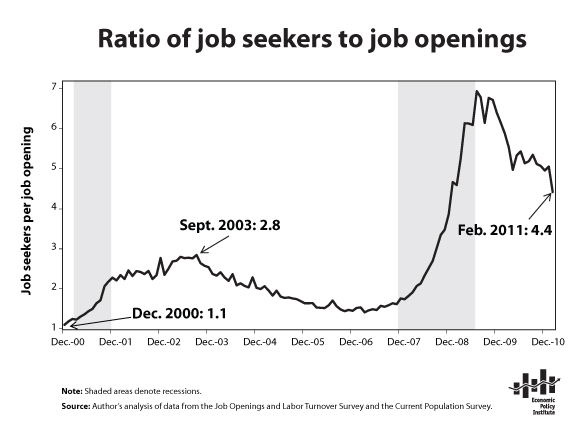This morning the Bureau of Labor Statistics released an encouraging February report from the Job Openings and Labor Turnover Survey (JOLTS) showing that job openings increased by 352,000 in February. Most of these job openings were in professional and business services, education and health services, and accommodation and food services.
February’s gain of 352,000 new openings was the largest monthly increase in over six years and more than made up for the declines of the last two months (which totaled 225,000). But there is still significant ground to make up: job openings remain 32% below where they were in 2007, and they are still below even the worst month of the early 2000s downturn.
The total number of job openings in February was 3.1 million, and the total number of unemployed workers was 13.7 million (unemployment is from the Current Population Survey). The ratio of unemployed workers to job openings was 4.4-to-1 in February, a substantial improvement from the revised January ratio of 5.1-to-1. However, February marks 26 months that the “job-seeker’s ratio” has been substantially above the 4-to-1 ratio. A job seeker’s ratio of 4-to-1 means that for 3 out of 4 unemployed workers, there simply are no jobs.

The Employment Situation report released April 1showed that, despite payroll job growth over the last year, the labor force is still smaller—by more than half a million—than it was a year ago; ; the working-age population grew by 1.9 million over that period, and consequently the proportion in the labor force is now 0.7 percentage points lower. If the participation rate had held steady over the last year, then there would be roughly 1.7 million more workers in the labor force right now, but instead those would-be workers are on the sidelines. Some observers claim that these missing workers may never enter or re-enter the labor market, but today’s numbers underscore the fact that it is far too early to draw such conclusions. The job-seeker’s ratio of 4.4 unemployed workers per available job is far worse than the worst month of the early 2000s recession (2.8-to-1 in September 2003). In this environment, where the chances of an unemployed worker finding a job are extremely low, the fact that the sidelined workers are not yet reentering the labor market en masse in search of work is no surprise—the conditions for job seekers remain very inhospitable.
(Kathryn Edwards and Nicholas Finio provided research assistance)
